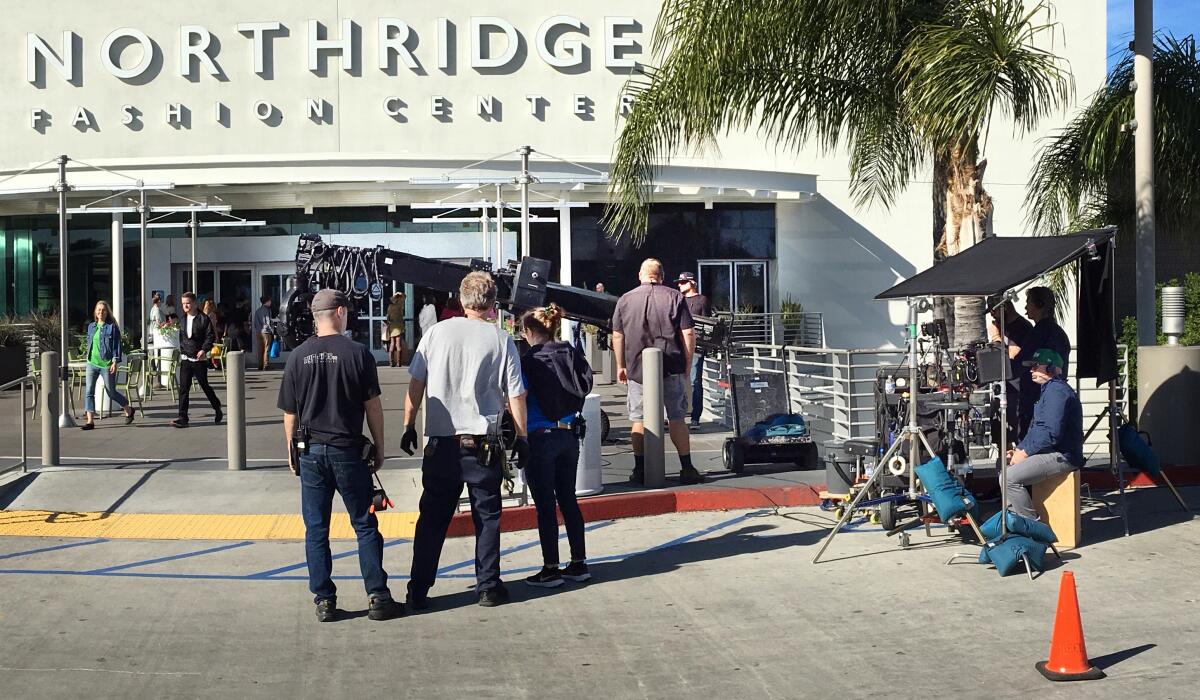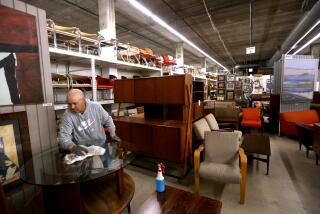Reopening California: Hollywood is figuring out how to start rolling again

Los Angeles movie studio Millennium Films was just days away from starting production on its Megan Fox horror movie “Till Death” in Sofia, Bulgaria, before fears of the coronavirus shut everything down.
Millennium President Jeffrey Greenstein doesn’t know when the film will get up and running at the company’s Nu Boyana Film Studios. But he knows that when it happens, film sets will feel very different from the pre-COVID-19 era.
Health and safety rules will be stricter. Social distancing standards could limit how workers interact with actors, filmmakers and department heads. Crew members may even have to wear protective masks on set.
“There’s a lot of uncertainty,” Greenstein said. “But the thing we need to all be thinking about is being as responsible as possible.”
Studio executives, independent producers, unions, government agencies and insurance specialists have begun to map out a return to what had been, until recently, a new golden age of film production.
Entertainment companies are desperate to roll the cameras again once they get the green light from public health officials. The stakes are high for the major studios, including Walt Disney and Warner Bros., which need to feed their nascent streaming platforms with more shows and films.
Over the last few weeks, the major studios have held meetings internally and with production service professionals to assess what a return to film and TV sets might look like. Shoots may return sooner in countries less hard-hit by the virus, such as Iceland, or that have less restrictive shutdowns and no post-travel quarantines such as Sweden or Denmark, where some producers have already laid out guidelines for filming.
“If there’s reliable testing, and people can come to work and be given a decent amount of social distance, I believe protocols will evolve to create workplaces where crews, who are hungry to get back to work, will feel safe.”
— Tom Rothman, Sony Pictures’ motion picture group chairman
Big movies that would normally have 300 people on set at once are finding ways of reducing that number to fewer than 75 by having people work in staggered groups and doing more work remotely, according to one studio executive not authorized to comment publicly. Production may resume with smaller-scale movies and shows, such as sitcoms, that can be made with smaller crews, tightly controlled sets and minimal travel.
Stars accustomed to in-person wardrobe departments may have to dress themselves. Makeup artists and hair dressers, who would normally touch up actors between takes, will probably have to observe shoots from iPads.
Sanitation crews will be brought on to disinfect sets and equipment throughout the day. Companies are also considering having crews effectively quarantine on studio property or in hotels near sets during production.
Studios don’t know when public health guidelines will allow them to resume production, nor do they know what types of social distancing restrictions governments will require.
But Tom Rothman, chair of Sony Pictures Motion Picture Group, said he’s confident companies will be able to address health and safety concerns.
“I don’t really imagine you’re going to be doing giant scenes with thousands of extras right off the bat,” he said. “But if there’s reliable testing, and people can come to work and be given a decent amount of social distance, I believe protocols will evolve to create workplaces where crews, who are hungry to get back to work, will feel safe.”
‘Contagion,’ a 2011 film, has become a hit on streaming sites as the world grapples with the coronavirus. For many watching now, it hits a bit too close to home.
Executives are anticipating productions could start up gradually around September in some places, with planning crews beginning set construction as soon as June in places like Georgia, which is one of the busiest filmmaking hubs outside of California.
Locally, FilmLA, the nonprofit group that handles film permits for the city and county of Los Angeles, said it is expecting a “first planning meeting” with public health officials in early May to discuss how to safely resume filming. A key consideration will be to address concerns in neighborhoods that film crews might spread disease.
“The film industry has always been a massive piece of the economy of this region, so figuring out a safe way to bring filming back is going to be critical to recovery,” said FilmLA President Paul Audley.
Hollywood unions are playing an important role in the discussions.
The Directors Guild of America is working with other guilds and unions and employers to put together a “comprehensive guide to help us all return safely to work,” DGA President Thomas Schlamme said recently.
The DGA has named “Contagion” film director Steven Soderbergh to lead a committee, consulting with “top epidemiologists in the field,” to examine issues filmmakers face and to make recommendations to the union’s board.
DGA National Executive Director Russell Hollander said “it is paramount that any return to set, whenever it may be, prioritizes the safety of industry workers. We are examining the complex issues involved through a methodical, science-based approach which includes consultation with top epidemiologists. Our work is still in its early stages, and while there are still so many unanswered questions to contend with, we know that a big part of it will be looking at testing.”
Even amid the pandemic, states and countries continue to vie for productions by showing they are gearing up for safe filming. Netflix said it was already shooting in countries such as Iceland and South Korea, where even though some restrictions on gathering in large numbers exist, widespread testing and quicker responses to outbreaks has contained the virus spread.
Several proposals for filming are circulating around Hollywood, including some from the European Institute for Health and Safety in Film Industry that outline protocols for testing, distancing on sets and protective equipment for makeup artists and other crew members. The institute requires contact-less fever testing for all crew members and catering by takeout, among other measures.
Some filmmakers anticipate they will have to double up roles. A director, for example, might have to double as a cinematographer, for example, to reduce the number of people on set.
Over the years, crews have increased in size, often using multiple cameras to increase efficiency.
But John Lindley, elected in March to lead the International Cinematographers Guild, said he doesn’t think staffs need to shrink. Cinematographers can work remotely or camera operators can work at least six feet from the cast, Lindley said. “I’m not convinced we have to give up job categories to get this done,” he said.
A crucial issue, he said, is to have a unified approach. “What is happening at the moment is a lot of smart people with good intentions are striking out on their own,” Lindley said. “To really succeed in figuring out how to work safely, we are going to need all the different guilds and unions and employers and insurance companies, to come together.”
Some producers are weighing whether to clean filming kits overnight or quarantine crews near film sets.
Budgets are likely to swell to account for increased cleaning costs, insurance costs and to factor in shutdowns.
“It’s going to be an interesting test of creative thinking and ingenuity,” said John Sloss, founder of Cinetic Media, a New York-based management, advisory and sales firm for the film industry. “I don’t think there’s a standard way in which this is all going to progress.”
Frank Patterson, president of moviemaking hub Pinewood Atlanta Studios, said he and his staff have spent the last six weeks devising new health and safety improvements with their studio customers. The sprawling 18-stage facility, home of blockbuster productions from Marvel, Sony and Warner Bros, has taken a major hit from the coronavirus shutdown. Typically, up to 6,000 people work on the lot daily.
A gradual change to normalcy will require improvements to studio security, facilities and profession behavior, he said. Pinewood, for example, is planning to ban unnecessary visitors and set up health screening stations at entrances. The studio also plans to introduce “microbial reduction” systems at production offices, install advanced hand-washing areas and provide mobile sanitation stations for crews.
During shooting, crew members will be kept more separate than normal. There will have to be more closed sets with limited staff.
“It may slow down production, but it will make it safer,” said Patterson. “How we organize crews and how we organize those work routines will be really important to keeping all workers healthy and safe.”
Tyler Perry‘s Atlanta-based studio has proposed sequestering smaller crews on the former army base, a location for Walt Disney’s “Black Panther,” as well as rapid coronavirus testing and cutting film shoots for a TV series to under 3 weeks.
A huge question for producers is how they will get their productions insured should someone get sick from COVID-19 on set, shutting down production and potentially raising the threat of lawsuits.
“Assume everyone will adopt the best practices but unless you have cast insurance, you can’t go into production.”
— Brad Krevoy, chief executive of Motion Picture Corporation of America
“Assume everyone will adopt the best practices, but unless you have cast insurance, you can’t go into production,” said Brad Krevoy, chief executive of L.A.-based Motion Picture Corporation of America, which makes Christmas movies for Netflix and the Hallmark Channel.
Many hope the federal government will create a backstop for insurers as happened after 9/11 so they can once again protect producers from liabilities that come from filming.
To get insurers on board, who now won’t cover losses linked to the pandemic, producers are considering separating actors and crew with glass or crews working in shifts.
Still, Krevoy is planning to deliver his batch of Christmas films on time despite the disruption and is looking to Canada as the place he will be able to restart shooting. “To be a producer you have to be born an optimist,” said Krevoy. “We will deliver for Christmas.”
More to Read
Inside the business of entertainment
The Wide Shot brings you news, analysis and insights on everything from streaming wars to production — and what it all means for the future.
You may occasionally receive promotional content from the Los Angeles Times.








